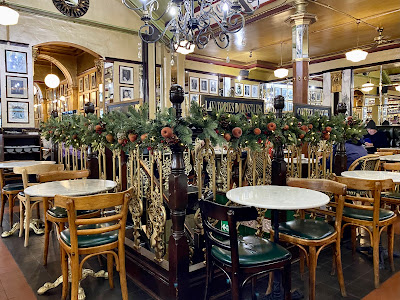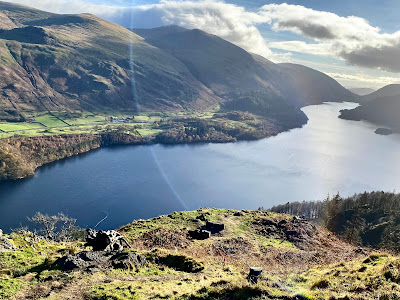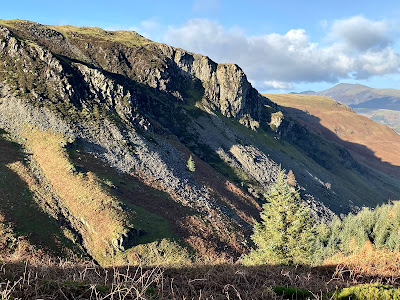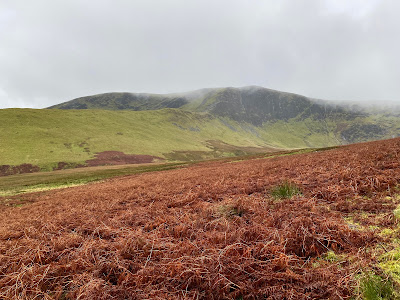 |
| l - r: Mum, Aunt Sheila, Grandad, Susan, Grandma, me & Neil |
My grandmother, Lily, came from Denby Dale in Yorkshire, one of 12 or 13 children, depending on how you counted them. She nursed Arthur, my Grandad, at the Auxillary Hospital after he was severely injured in the Great War and they married a couple of years later when he had recuperated. Hospitals were the alternative dating venues to dance halls for that generation. They moved to a house in Preston, where they had a single child, my mother before the great depression dampened the birth rate. It meant that my mother had a plethora of aunts, uncles, and cousins in Yorkshire. This platoon of relatives was recycled for my generation. As a child, my father hired a car three or four times a year and we drove via Todmorden, and Hebden Bridge, where it always seemed to be raining, to visit relatives scattered between Denby Dale and Wakefield.
We were subjected to an interminable series of cups of tea, sandwiches, and cakes as we pottered around the various relatives where I collected half-crowns from the cast of great uncles. However, the best thing about the visits was to see my mother's bridesmaid, Sandra, another only child whose age was halfway between me and my mother. Was she an aunt or a cousin? It didn't matter, she was my favourite relative and always treated me as a young brother. She was fun, attractive, and had a charisma that captivated everyone she met. She had attended the Wakefield Girls Grammar School but few girls from working backgrounds went on to University in those days. She left school for a successful career in nursing after giving up a career in a solicitor's office which she found incredibly dull. The whole family came together for her wedding to a Yorkshire farmer in 1960. The Lancashire side of the family is on the left of the photo with my sister next to me and my brother in the arms of Great Uncle George, the mill manager in Denby Dale. It was the first wedding I had attended and there was a full house of relatives in attendance,
Sandra's husband, Eric was a quiet, amiable, and sanguine person who was taking over the running of his father's farm. They lived in part of the large stone farmhouse in the rhubarb triangle, west of Wakefield. The low brick-built rhubarb sheds were stoked by plentiful supplies of coal from the pits that extended underneath the farm. Forced rhubarb in the winter months brought a good price at a time of the year when there was a paucity of other crops. In summer they grew peas, cauliflowers, potatoes, and hay and kept a herd of chalorois cows.
When I was a teenager, Sandra invited me to stay with them during my summer holidays to work on the farm. It was always an enjoyable break. I would have to bring in the cows for morning and evening milking, reset the electric fences to give them fresh grass for grazing, go with Eric to collect girls from the nearby village on the back of his lorry for pea picking, and then supervise them, On other days I would work with Eric loading bales of hay onto trailers and then stacking the bales into the barns. After the early evening milking, we would take the crops of vegetables to markets in Manchester and Halifax.
After lunch each day, Eric would disappear into his office to sort his paperwork and order supplies. I would clear the lunch, wash up, and take Sandra a cup of tea whilst she was breastfeeding her babies, she had three in the years I was visiting and I was asked to be a godfather of her third. She was very broad-minded about things and would happily demonstrate the intricacies of breastfeeding. She would ask me to change their nappies and settle them down for an afternoon sleep whilst she got on with other things. In the evenings we would play cards and games and there was much laughter and we would tease each other. Eric thought I would make a good farmer as I had lots of stamina and was able to multi-task. Sandra thought I would make a better mother because I helped her around the house, and looked after the children and most men couldn't multi-task. Sandra and I would chatter incessantly, particularly on the days when Eric went for a liquid lunch with the local Farmer's Union, an event that extended well into the afternoon.
In later years I would visit the farm when I was a student at university and play with the children. When collecting conkers for them, I had climbed a chestnut tree next to the house, the branch I was standing on broke, and I fell 25 feet onto the farm track. I landed on my back with a dull thud and was completely winded but surprisingly unhurt. All the then children remember the occasion in detail and believed that I might have been dead, Sandra used her nursing skills to bring me round and it cemented my reputation as a good sport and survivor.
As my grandma's generation passed away in the 1960s, 70s, and 80s, Sandra and her family became my only remaining relatives in Yorkshire. We kept in touch meeting at funerals, significant birthdays and at the Denby Dale Pie event in 1968, the last time that most of the family were together. We then saw less of Sandra's family as 250 miles was a long way to travel and we had three children of our own to look after but we kept in touch by phone. We met at my sister's 60th birthday and Aileen and I made a trip to Yorkshire to take Sandra out for her 80th birthday. Since Covid, like with so many others, our contact lapsed. I had decided to visit my sister in Preston for the first time since Covid and I thought it would be good to see Sandra and her family, it was only another 65 miles to travel. She seemed pleased and invited me to stay the night and she arranged for me to see all her children.
I arrived mid-morning after a dicey drive across the Pennines to Yorkshire on the M62, which has regressed into a trucker's race track. I should have gone on the old route through Todmorden as it was raining anyway. Sandra had hardly changed, she was welcoming as always and her dog, Molly, was just as friendly. We talked without hesitation but with lots of deviation for 2 hours, her memory and sense of humour were as sharp as ever. When we realised the time, Sandra made lunch in next to no time so we could make the most of the afternoon. We drove to see both of her sons who lived just a few miles away.
The younger son has recently retired from his online business to pursue his interest in wildlife. His sister came round and we watched an albino squirrel in the garden as we caught up on how our lives had taken shape. We continued to see the oldest son who lives in a house built on the site of the old family farmhouse. It had to be demolished because it was undermined by the coal workings that presumably provided the fuel for the forced rhubarb. In the evening all the children and their partners turned out for a family reunion at a pub/restaurant in Ossett where Yorkshire's generosity of spirit was extended to a Lancastrian. The conversation brought together family nostalgia with tales of lifestyle changes before we were whisked home in two electric cars. Sandra now has 8 grandchildren and 10 great-grandchildren. She seems to have an easy relationship with all of them, she is the undisputed paragon of the Yorkshire family.
 |
| Molly |




















































